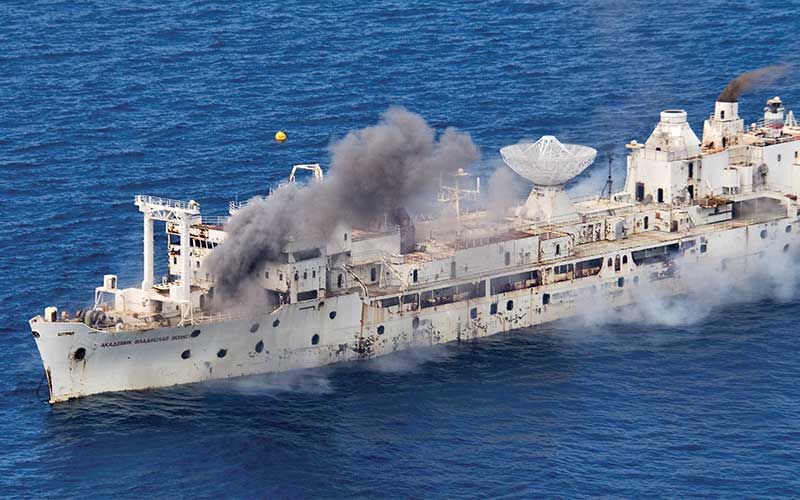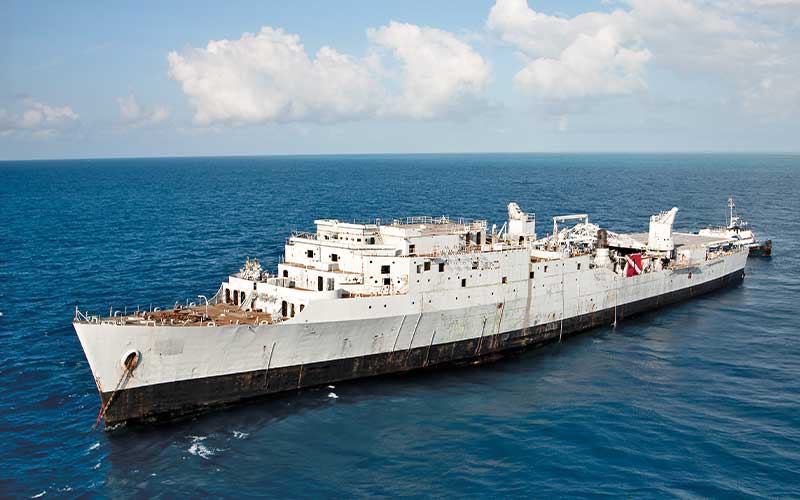At 10:22 a.m. on May 27, 2009, I was sitting on a tugboat just 200 yards (183 m) astern of a 523-ft (159-m) behemoth, the Gen. Hoyt S. Vandenberg. I know that from looking at the EXIF data on my photos, for at that precise moment the camera caught the explosive charges cutting gaping holes in the ship’s hull. Filled with 300 tons of concrete and pig-iron ballast, the Vandenberg followed its last set of orders with military precision: It sank to the sea floor in just under two minutes, settling in upright, intact and ready to receive divers.
Just like that — after 12 years of planning and work — Key West was home to the newest world-class wreck dive.
The Vandenberg finds itself in good company. Although the Keys have historically been better known for the fishy, shallow reefs of the Florida Keys National Marine Sanctuary, they are also home to an armada of sunken ships that in size and scope rival many a small nation’s navy. If wrecks are your passion, then the Keys just might be your next destination.
Key West: Diving the Vandenberg
The Vandenberg has a long and storied past. Originally built as a troop transport under the name USNS Gen. Harry Taylor, the ship saw duty in World War II. It was decommissioned in 1946, briefly reacquired by the Navy in the 1950s and retired again. The ship was later transferred to the U.S. Air Force, underwent an extensive refitting to serve as a missile tracking ship and recommissioned as the USAFS Gen. Hoyt S. Vandenberg. It was retired from military service a final time in 1983 and joined the James River Reserve Fleet. Before being selected by the Key West-based Artificial Reefs of the Keys for artificial reef duty, the Vandenberg served as a set for the 1998 action move “Virus.”

The immense wreck, from its bluff superstructure to the massive radar dishes, is a marvel to dive. The ship offers a solid 100 ft (30 m) of relief with dive profiles for everyone from novice divers to advanced technical and wreck-penetration divers. There are seven mooring buoys on the Vandenberg, and you’ll need to dive them all to get the complete picture of the wreck. On my first dive shortly after the vessel sank, I went down the mooring line forward of the bridge, anchored to the kingpost. Even though the Vandenberg rests at a depth of 140 ft (43 m), on my dive I never went below 82 ft (25 m) and could have stayed even shallower, exploring interesting structures such as its enormous radar dishes.
It’s amazing to think that this wreck will only get better with each passing year as it becomes a living reef. By now the ship sports a light, fuzzy cloak of algae as Mother Nature begins to decorate the wreck in her inimitable style. Soon the bright white paint will fade, and the Vandenberg‘s sharp, manmade edges will be smoothed out by encrusting growth. With that transformation come fish that graze on algae. Fish, of course, bring out even bigger fish, the top-of-the-food-chain predators. And with the Gulf Stream gusting over the wreck, you never know what pelagic creature might wander in for a reprieve from a life drifting along in the current. Turtles, in particular, like to snooze in the lee of a good shipwreck.
Before long, a complete reef ecosystem will tower above what had been an area of flat, featureless sand. With each passing year, the ship will attract more fish and more color — all the more reason to make a visit to Key West and the Vandenberg an annual pilgrimage.

Key Largo: More than the Spiegel Grove
Wrecks have always been a part of what makes Key Largo the “Diving Capital of the World,” but its most recent steel reef — the 510-ft (155-m) Spiegel Grove — is clearly the most notorious. Landing upside down after it sank prematurely on May 17, 2002, a salvage crew managed to lay the ship on its starboard side, and there it sat for three years until, incredibly, on July 9, 2005, the passing waves from Hurricane Dennis set it perfectly upright. Like the Vandenberg, the Grove is so immense that each dive is but a vignette of the whole.
The massive main deck is covered in coral and sponge growth, but I like to dive around the wheelhouse and typically as far astern as the rear gun emplacements and well deck cranes. Bring a small light to peer inside the wreck’s structure to bring out the colors of the dense orange cup corals growing inside, but resist the urge to enter any overhead environment beyond ambient light. The ship’s maze of interior passageways offer interesting profiles, but only for properly trained and equipped wreck-penetration divers.

Before the Spiegel Grove, wreck-obsessed divers knew Key Largo as home to the City of Washington, the Benwood and the USCGC Duane. City of Washington was sitting aside the Maine when it exploded in Havana harbor. It picked up the survivors that night but came on hard times later, ignominiously being towed as a barge when it ran aground on a shallow patch of reef known as the Elbow. Blown apart as a hazard to navigation, the wreck still attracts a considerable amount of marine life, including nurse sharks and a big barracuda. The Benwood likewise suffered its final blows at the hands of a demolition team, but it is far more intact, particularly the bow section. Running without navigation lights due to German U-boat activity off the Florida coast, the Benwood collided with another ship on the night of April 9, 1942. Resident schools of porkfish, goatfish and schoolmaster snapper are the iconic highlights of the wreck. With a maximum depth of just 40 ft (12 m), the Benwood is a great place for a leisurely shallow dive, and it’s a nice second tank after diving the Spiegel Grove.

The 327-ft (100-m) Duane sits upright and intact and is easy to see in a single dive, but divers return time and again to savor the colorful encrusting coral and sponge growth accumulated over the past two decades. On a single tank, most divers can loop from the bow, past the wheelhouse and around the radar tower. It’s a nice easy circuit that never takes you deeper than 90 ft (27 m). Whenever I dive the Duane, I find myself lingering amidship, shooting up toward the radar tower. Silhouetted by the Florida sun, the tower makes a great photo op. From barracuda to schools of amberjacks, you never know what will swim into the frame. For technically oriented wreck divers, the Duane‘s sister ship, the Bibb, is nearby, resting on its side in slightly deeper water.
Islamorada: Fish and Ships, Anyone?
Islamorada’s premier wreck is the Eagle, a 269-ft (82-m) coastal freighter that proves what the ocean can do with a good wreck and a little bit of time. A derelict at the time it was acquired by the Islamorada dive community and sunk as an artificial reef on Dec. 19, 1985, it came to rest in the sand on its starboard side in 110 ft (34 m) of water. Its port rail tops out at about 80 ft (24 m), and the entire wreck now sports a mature, photogenic coating of coral and sponge growth. In 1998, storm surge from Hurricane Georges broke its back, leaving it in two sections but also making the wreck an even bigger magnet for marine life. Tomtate grunts, multiple goliath grouper and some uncommonly large blue angelfish now reside here.
Lower Keys: Last Call
The big dive attraction off Big Pine Key and the Lower Keys is Looe Key, a spur-and-groove reef structure designated as its own National Marine Sanctuary nearly three decades ago. As a further reminder of the Key’s maritime heritage, this reef is named for a 46-gun frigate (HMS Looe) that ran aground here in 1744. Very little of the wooden wreck remains aside from coral-covered ballast stones, so wreck divers head straight for the Adolphus Busch Sr. The signature wreck of the Lower Keys is a 210-ft (64-m) coastal freighter sunk intentionally on Dec. 5, 1998. It now sits upright in 115 ft (35 m) of water about 3.5 nautical miles (6 km) west of Looe Key’s main dive sites. On most dives, you can expect to see barracuda cruising the decks and several large goliath grouper milling about.

Marathon: High Voltage Diving
While there are several historical shipwrecks off Marathon, including Flagler’s Barge, a 100-ft (30-m) platform used in the 1920s during the construction of the Flagler Railroad, the most popular shipwreck in Marathon is clearly the Thunderbolt. Originally commissioned in 1942 as a minelayer, it later served to deploy deep-water cables. However, its name derives from the time it was owned by Florida Power and Light and actually used to attract lightning strikes for scientific research.
The Thunderbolt was cleaned, made diver-friendly and scuttled as an artificial reef on March 3, 1986. It now sits upright on a sand bottom at a depth of about 120 ft (37 m), with its intact wheelhouse topping out at about 75 ft (23 m). Its signature feature is a huge cable wheel at about 85 ft (26 m), which is usually about as deep as I dive the Thunderbolt. Some people like to drop to the sea floor to see the ship’s propellers, but as they are mostly buried in sand, I find little reason to burn my air and no-deco time to see them. The wheelhouse is far more interesting, both as a foreground for diver portraits and for the resident barracuda.

To Sink or Scrap
Two of the biggest wrecks in the Florida Keys — the 510-ft (155-m) Spiegel Grove and the 523-ft (159-m) Vandenberg — began their journey to the Florida Keys from the back waters of Virginia’s James River. It’s there that the Maritime Administration (MARAD) maintains the James River Reserve Fleet, one of three massive flotillas of outdated and surplus ships (many veterans of World War II) that make up the National Defense Reserve Fleet (NDRF). It costs taxpayers a lot of money to keep the old vessels afloat, and Uncle Sam would love nothing more than to see many of them put to good use as artificial reefs rather than go to a scrap yard.
“By taking ships like the Vandenberg and instead turning them into artificial reefs, we create a new conservation opportunity for marine wildlife and also generate economic activity,” says James Connaughton, former chairman of the White House Council on Environmental Quality.
There is no shortage of available ships — as of June 30, 2009, there were more than 200 surplus vessels sitting idle — but sinking them as dive sites is expensive and time-consuming. Vessels must be cleaned to meet strict environmental standards and stripped of potential hazards, like the 900,000 ft (274,320 m) of wiring that had to be removed from the Vandenberg. In all, the Vandenberg cost $8 million to sink, and the cleaning and preparation required more than 50,000 man-hours. But the results are spectacular, and the investment will pay off for decades as artificial reefs are a proven boon to marine life and local tourism economies.

© Alert Diver — Q4 Fall 2009